SEO
10 Different Ways To Get Organic Page 1 Google Rankings
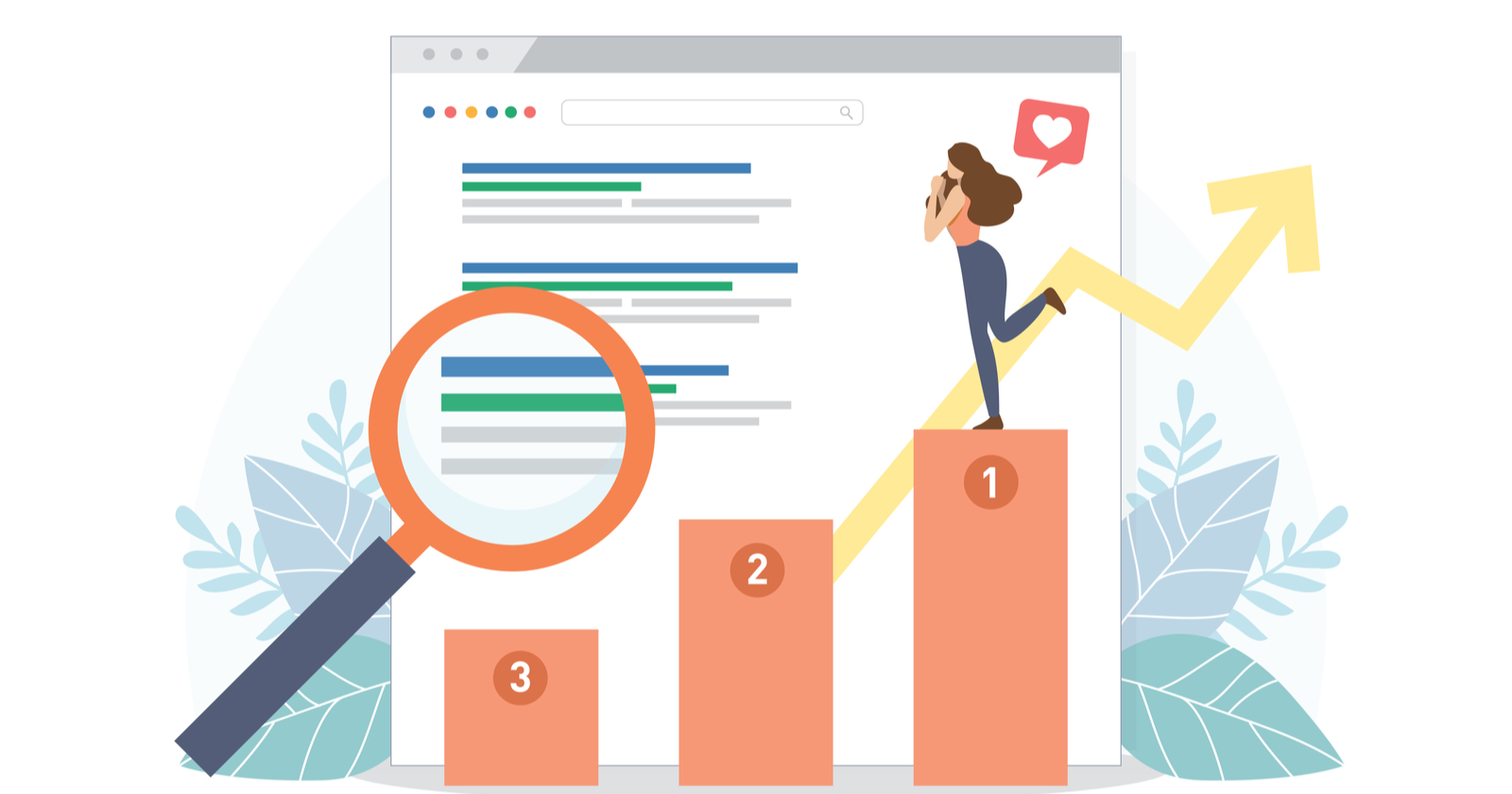
Google search has been continually evolving since the very beginning.
Over the past 10 years, much of that evolution was driven by improvements in technology but also changes in what users expect.
Here are 10 opportunities for more traffic from Google and how to get it.
Google has steadily been committed to making search results more useful and also in response to changing user behavior, lately driven by the new demands of mobile search.
With the introduction of knowledge panels in 2012 followed by featured snippets in 2014 – not to mention the local search packs that preceded that – optimizing for 10 blue links has become anachronistic.
It’s an SEO practice from the past.
Rich results, featured snippets, Map Pack results, knowledge panels, and more are opportunities for more site visitors from an increasingly dynamic search results page.
How can you compete? By staying up-to-date.
In this post, we’re going to explore the different ways you can appear on Google’s Page 1 by optimizing content for various types of search results.
Note: this is in no way comprehensive and is ever-changing, as Google constantly tests and launches new features (and sometimes takes our favorite toys away).
Core Types Of Rich Search Results
The examples below will fall into one of these categories (and there may be some overlap):
- Rich Results.
- Featured Snippets.
- Knowledge Panels.
- Local Business Results.
Rich results are enhanced organic search result that adds information to a plain text search result and expands it as a result.
Rich results make your results more dynamic, visible, and engaging.
Featured snippets are enhanced answers that appear at the top of search results (sometimes even above paid results).
Sometimes referred to as “position zero,” it’s actually position 1 out of the traditional 10 organic positions.
These results are enhanced organic search results that contain additional visual enhancement, including stars, as part of a carousel of search results and may include images from multiple websites.
-
 Screenshot from search for [wordpress stored xss vulnerability], Google, March 2022
Screenshot from search for [wordpress stored xss vulnerability], Google, March 2022
This search result typically answers an informational query and may include text, a numbered (or non-numbered) list, and images (sometimes from multiple sites).
Featured snippets make your organic search listings more dynamic, visible, and engaging.
Research data from different sources in 2020 and also 2021 estimates that featured snippets display in the search results between 11% and 19% of SERPs.
It’s important that you’re optimizing for the search results enhancements that make sense within the context of your business goals and searcher intent.
Knowledge panels are information panels about what is generally referred to as entities. What is meant by the word entities are people, places, organizations, movies, music, and other things.
Knowledge panels provide quick information about entities that are automatically generated.
The entities that are subjects of knowledge panels have the opportunity to “claim” a knowledge panel and influence the information that is in that knowledge panel.
Google also accepts user feedback about knowledge panels.
Knowledge panels are an opportunity for organizations and individuals to present their information through Google.
Google Business Profile (formerly known as Google My Business) is a Google program that allows local-based businesses to manage their online presence whenever someone searches for their business, a local product, or a service.
The data in Google Business Profile powers the local Map Pack in the organic search results.
It helps to surface the correct information in Google Maps, and it provides a way to control the business profile shown in Google’s search results including things like phone numbers, addresses, and hours.
Check out a comprehensive overview of Google Business Profile if you’re just getting started or looking for improvements in that area.
The likelihood that you’ll earn a result in one of these formats depends on hundreds of factors that only Google knows, but you can safely assume that these weigh heavily into the mix:
- Relevance to the query.
- Vertical, industry segment, or category (such as flights, hotels, or restaurants).
- Correct use of structured data.
- Content quality.
Here are 10 ways you can get more Page 1 – and Position 1 or even the coveted Position Zero – results in Google.
For each one, you’ll find tips and resources to help you optimize for that type of result (although this is in no way a guarantee that you’ll achieve it).
1. Plain Text Organic Search Results
Achieving the top plain text organic search result in Google is more difficult than ever before.
Not only is search extremely competitive, but search results consisting of just plain blue links are becoming rare for certain kinds of questions, particularly “how-to” type search queries.
As for ten blue links, those essentially don’t exist anymore on mobile devices because search results on mobile are shown with a continuous scroll so that users no longer have to click to the next page of search results.
 Screenshot from search for [should publishers use link disavow tool?], Google, March 2022
Screenshot from search for [should publishers use link disavow tool?], Google, March 2022How To Optimize For It
- Answer a searcher’s need for information.
- Be superior in every way. Seriously, that’s what it takes.
2. Video Rich Results
It’s no surprise that YouTube results feature prominently in Google’s search results.
Until last year, videos appeared as a thumbnail alongside the blue text link.
Now, Google organizes them into Video Rich Results that are sometimes displayed above the regular text link results.
 Screenshot from search for [how to cook with a wok?], Google, March 2022
Screenshot from search for [how to cook with a wok?], Google, March 2022How To Optimize For It
- Help searchers and search engines understand your video’s content with relevant, quality titles, descriptions, and tags.
- Use the appropriate VideoObject Structured Data.
3. Carousel Rich Results
Google’s documentation states that carousel rich results are available for four specific kinds of content:
- Course
- Movie
- Recipe
- Restaurant
It also appears to be available for other entertainment media besides Movies, like podcasts, and even for Victorian-era authors.
 Screenshot from search for [authors of victorian fiction], Google, March 2022
Screenshot from search for [authors of victorian fiction], Google, March 2022How To Optimize For It
4. Featured Snippet
A type of organic search result that displays approximately 50 words of text, the page title and URL, and a featured image thumbnail.
Featured snippets are an excellent opportunity to get more eyes on your thought leadership material.
 Screenshot from search for [what are google algorithms?], Google, March 2022
Screenshot from search for [what are google algorithms?], Google, March 2022How To Optimize For It
- Answer informational queries relevant to your business and its products or services.
- Keep this paragraph format and a simple Q&A approach in mind as you create content you hope to rank on this type of result.
- Do the legwork of researching what questions people have and see what results come up. Are there opportunities where no result renders? Are there results that seem low quality or outdated? Start there and use your learnings from those early efforts with the easiest opportunities to target more competitive search terms.
5. Data Table Snippet
Tables can be an effective way to share information or demonstrate concepts.
Note that Google initially developed this result for news media.
However, as brands increasingly function as publishers and may even tackle timely news stories, this could be an opportunity for businesses, as well.
Google is also able to read data that is displayed in HTML tables (without structured data) and display them as a Data Table Snippet.
 Screenshot from search for [europe search engine market share], Google, March 2022
Screenshot from search for [europe search engine market share], Google, March 2022How To Optimize For It
- Explore Google’s approach to dataset discovery and find developer resources here.
- Read more about displaying data tables in search results here.
6. Top Stories Carousel
The Top Stories carousel displays the headline, source name, and an expanded image. These results are open to blogs as well as media websites.
Proper optimization here can result in your article being automatically converted into action on Google Assistant, enabling people to access your content through the voice assistant.
 Screenshot from search for [google search label for cited sources], Google, March 2022
Screenshot from search for [google search label for cited sources], Google, March 2022How To Optimize For It
- Google will display news content in the top stories carousel regardless if the article is published in AMP or not.
- What is important is that the webpage uses the correct structured data in order to pass along relevant information that can be used to show in the Top Stories section of Google’s search results.
- Additionally, be sure to use the right size featured image. It is recommended by Google that images for AMP pages be a minimum of 1200 pixels wide.
- For non-AMP pages, Google’s article structured data developer page recommends a minimum of 696 pixels wide. However, Google’s guidelines for the Google Discover program recommend all pages use images with a minimum of 1200 pixels in width. So for Google News, it’s best to use images that are a minimum of 1200 pixels wide in order to remain eligible for being shown in Google Discover as well as Google News.
7. Local Business Knowledge Panel Card
With the proper markup and optimizations, business panels can have a great deal of functionality and interactivity.
Not only can searchers find your address, phone number, and hours of operation without clicking through to your site, but they may be able to complete actions such as booking a table, placing an order, or making an appointment.
Your panel expands as more relevant information is added, making it incredibly hard to miss on both desktop and mobile.
 Screenshot from search for [greystone prime steakhouse], Google, March 2022
Screenshot from search for [greystone prime steakhouse], Google, March 2022How To Optimize For It
- Expand your panel as much as possible by populating your Google Business Profile (GBP) with descriptive, relevant information to help searchers make a decision about your business.
- Monitor your GBP dashboard and interact regularly with searchers who leave reviews, ask questions, or otherwise attempt to engage your business.
- Keep all information up-to-date in order to avoid poor searcher experience (such as directing someone to a closed location) and eroding search engine trust in your brand.
- Find specific markup to facilitate actions such as reservation taking or online ordering here.
8. Event Rich Result
Marking up your events pages with Event Structured Data helps this information appear in Google Search and Maps results.
Searchers can also click through to see more events and filter by date.
 Screenshot from search for [concerts in boston may 2022], Google, March 2022
Screenshot from search for [concerts in boston may 2022], Google, March 2022How To Optimize For It
9. Review Snippet
When Google finds the proper markups for reviews, it may expand your rich result with a review excerpt or an average combined rating score.
Currently, this rich search result type is available for books, local businesses, movies, music, products, and recipes.
 Screenshot from search for [the fundamentals of brand SERPs for business book review], Google, March 2022
Screenshot from search for [the fundamentals of brand SERPs for business book review], Google, March 2022How To Optimize For It
- Follow Google’s instructions here for optimization whether you want to add a simple review, embed a review into another schema.org type using its review property, add ratings to your reviews, or add aggregate ratings.
10. Logo In Knowledge Panel & Search
Reinforce your branding at every opportunity by ensuring that your logo appears in your business panel and in Search.
 Screenshot from search for [bing], Google, March 2022
Screenshot from search for [bing], Google, March 2022How To Optimize For It
- Use a logo that is 112 x 112px, at minimum, in .jpg, .png, SVG or WebP format.
- Make sure that the image URL is crawlable and indexable.
- Apply the proper markup.
Overall Best Practices For Rich Search Results Optimization
- Follow Google’s structured data guidelines. It’s pretty important to them that you do so, as evidenced by their guide entitled (you guessed it): Follow the structured data guidelines.
- If you’re just getting started, try out Google’s Structured Data Codelab to experiment with several different types of structured data in a controlled, instructive environment.
- Use Google’s Rich Results Test to see if your page supports rich results and get recommendations to improve.
- Avoid being perceived by Google as a structured data spammer by resolving issues and avoiding shady behavior such as marking up content that isn’t visible to users.
- Run Google’s Rich Result Status Report after implementation and regularly as you continue to optimize your site’s content. You’ll see which rich results Google could or couldn’t read from your site and get troubleshooting information for rich result errors. You can then request a re-crawl after you have fixed any problems.
These are just a few of the more universally appealing ways to get multiple Page 1 results. There are plenty more, especially once you get into vertical-specific results.
Before chasing any one type of result, make sure you understand the opportunity, competition, and searcher intent you hope to get in front of with that specific type of content.
Enhanced Search Results Are An Opportunity
The concept of search results as a listing of 10 blue links is a thing of the distant past.
The various rich search results provide myriad opportunities to be discovered in a way that provides new opportunities to cultivate more meaningful traffic than ever before.
More Resources:
Featured Image: Zouls/Shutterstock
SEO
How To Write ChatGPT Prompts To Get The Best Results

ChatGPT is a game changer in the field of SEO. This powerful language model can generate human-like content, making it an invaluable tool for SEO professionals.
However, the prompts you provide largely determine the quality of the output.
To unlock the full potential of ChatGPT and create content that resonates with your audience and search engines, writing effective prompts is crucial.
In this comprehensive guide, we’ll explore the art of writing prompts for ChatGPT, covering everything from basic techniques to advanced strategies for layering prompts and generating high-quality, SEO-friendly content.
Writing Prompts For ChatGPT
What Is A ChatGPT Prompt?
A ChatGPT prompt is an instruction or discussion topic a user provides for the ChatGPT AI model to respond to.
The prompt can be a question, statement, or any other stimulus to spark creativity, reflection, or engagement.
Users can use the prompt to generate ideas, share their thoughts, or start a conversation.
ChatGPT prompts are designed to be open-ended and can be customized based on the user’s preferences and interests.
How To Write Prompts For ChatGPT
Start by giving ChatGPT a writing prompt, such as, “Write a short story about a person who discovers they have a superpower.”
ChatGPT will then generate a response based on your prompt. Depending on the prompt’s complexity and the level of detail you requested, the answer may be a few sentences or several paragraphs long.
Use the ChatGPT-generated response as a starting point for your writing. You can take the ideas and concepts presented in the answer and expand upon them, adding your own unique spin to the story.
If you want to generate additional ideas, try asking ChatGPT follow-up questions related to your original prompt.
For example, you could ask, “What challenges might the person face in exploring their newfound superpower?” Or, “How might the person’s relationships with others be affected by their superpower?”
Remember that ChatGPT’s answers are generated by artificial intelligence and may not always be perfect or exactly what you want.
However, they can still be a great source of inspiration and help you start writing.
Must-Have GPTs Assistant
I recommend installing the WebBrowser Assistant created by the OpenAI Team. This tool allows you to add relevant Bing results to your ChatGPT prompts.
This assistant adds the first web results to your ChatGPT prompts for more accurate and up-to-date conversations.
It is very easy to install in only two clicks. (Click on Start Chat.)
For example, if I ask, “Who is Vincent Terrasi?,” ChatGPT has no answer.
With WebBrower Assistant, the assistant creates a new prompt with the first Bing results, and now ChatGPT knows who Vincent Terrasi is.
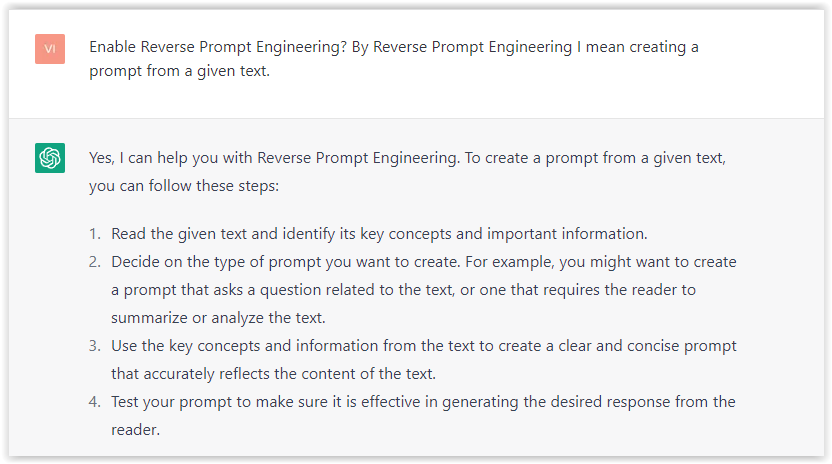 Screenshot from ChatGPT, March 2023
Screenshot from ChatGPT, March 2023You can test other GPT assistants available in the GPTs search engine if you want to use Google results.
Master Reverse Prompt Engineering
ChatGPT can be an excellent tool for reverse engineering prompts because it generates natural and engaging responses to any given input.
By analyzing the prompts generated by ChatGPT, it is possible to gain insight into the model’s underlying thought processes and decision-making strategies.
One key benefit of using ChatGPT to reverse engineer prompts is that the model is highly transparent in its decision-making.
This means that the reasoning and logic behind each response can be traced, making it easier to understand how the model arrives at its conclusions.
Once you’ve done this a few times for different types of content, you’ll gain insight into crafting more effective prompts.
Prepare Your ChatGPT For Generating Prompts
First, activate the reverse prompt engineering.
- Type the following prompt: “Enable Reverse Prompt Engineering? By Reverse Prompt Engineering I mean creating a prompt from a given text.”
 Screenshot from ChatGPT, March 2023
Screenshot from ChatGPT, March 2023ChatGPT is now ready to generate your prompt. You can test the product description in a new chatbot session and evaluate the generated prompt.
- Type: “Create a very technical reverse prompt engineering template for a product description about iPhone 11.”
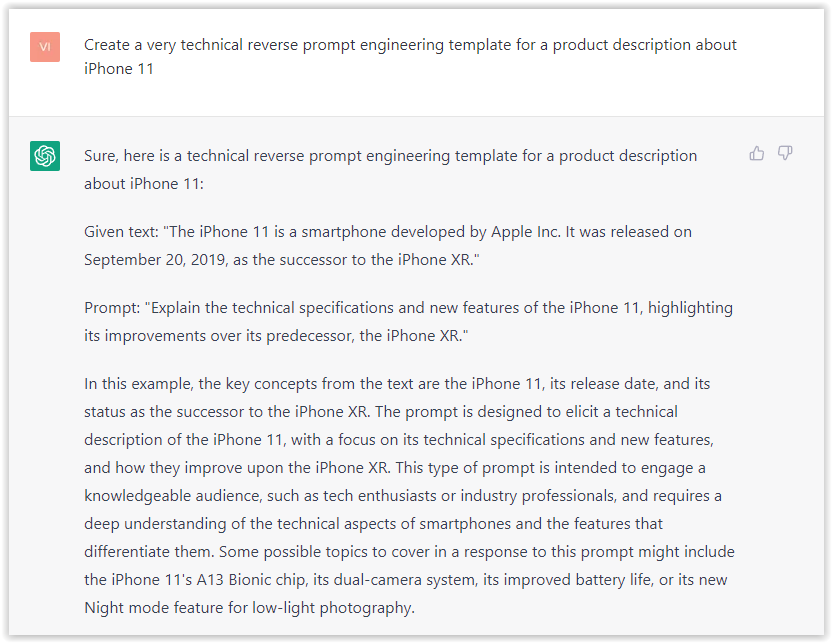 Screenshot from ChatGPT, March 2023
Screenshot from ChatGPT, March 2023The result is amazing. You can test with a full text that you want to reproduce. Here is an example of a prompt for selling a Kindle on Amazon.
- Type: “Reverse Prompt engineer the following {product), capture the writing style and the length of the text :
product =”
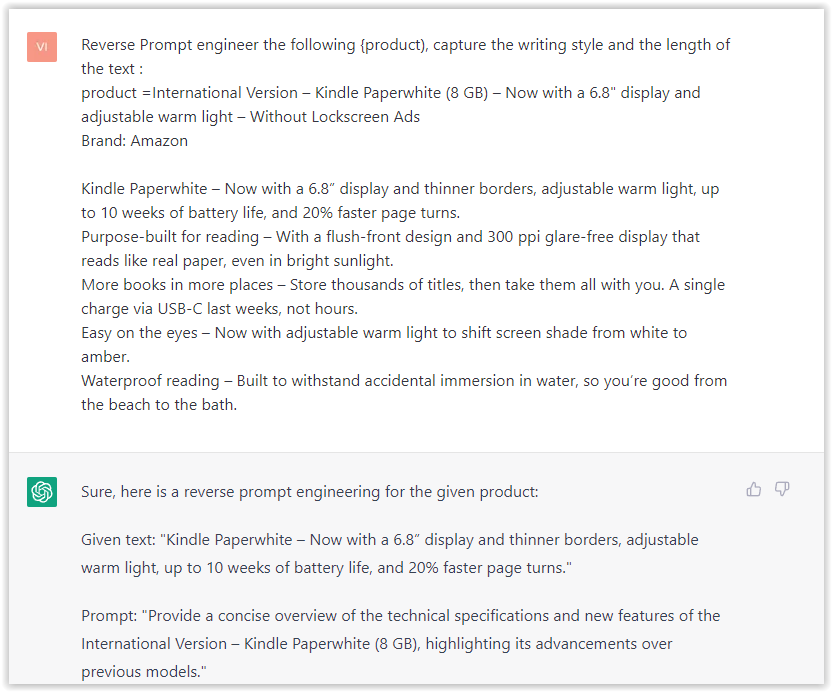 Screenshot from ChatGPT, March 2023
Screenshot from ChatGPT, March 2023I tested it on an SEJ blog post. Enjoy the analysis – it is excellent.
- Type: “Reverse Prompt engineer the following {text}, capture the tone and writing style of the {text} to include in the prompt :
text = all text coming from https://www.searchenginejournal.com/google-bard-training-data/478941/”
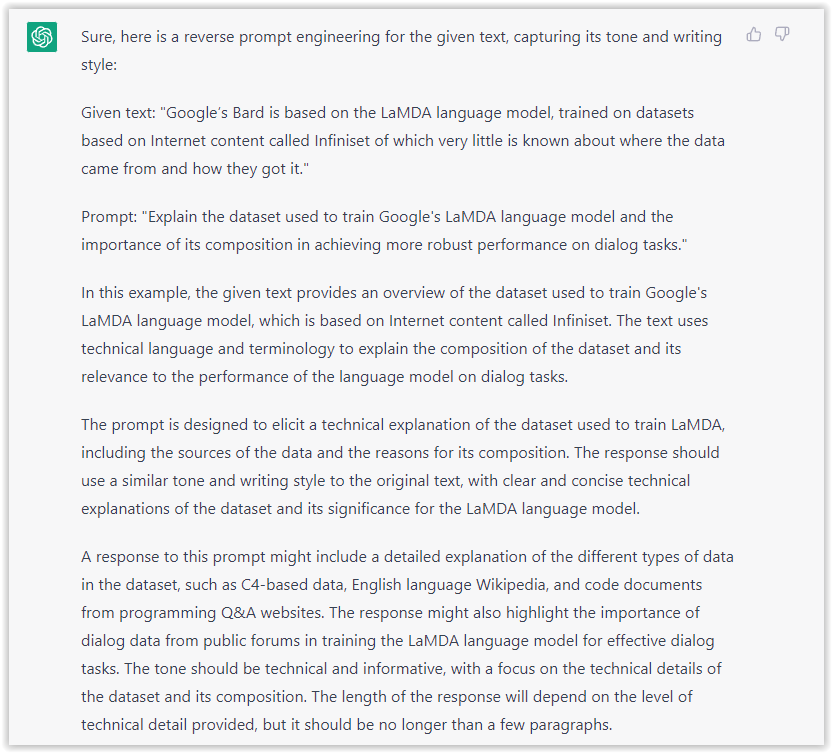 Screenshot from ChatGPT, March 2023
Screenshot from ChatGPT, March 2023But be careful not to use ChatGPT to generate your texts. It is just a personal assistant.
Go Deeper
Prompts and examples for SEO:
- Keyword research and content ideas prompt: “Provide a list of 20 long-tail keyword ideas related to ‘local SEO strategies’ along with brief content topic descriptions for each keyword.”
- Optimizing content for featured snippets prompt: “Write a 40-50 word paragraph optimized for the query ‘what is the featured snippet in Google search’ that could potentially earn the featured snippet.”
- Creating meta descriptions prompt: “Draft a compelling meta description for the following blog post title: ’10 Technical SEO Factors You Can’t Ignore in 2024′.”
Important Considerations:
- Always Fact-Check: While ChatGPT can be a helpful tool, it’s crucial to remember that it may generate inaccurate or fabricated information. Always verify any facts, statistics, or quotes generated by ChatGPT before incorporating them into your content.
- Maintain Control and Creativity: Use ChatGPT as a tool to assist your writing, not replace it. Don’t rely on it to do your thinking or create content from scratch. Your unique perspective and creativity are essential for producing high-quality, engaging content.
- Iteration is Key: Refine and revise the outputs generated by ChatGPT to ensure they align with your voice, style, and intended message.
Additional Prompts for Rewording and SEO:
– Rewrite this sentence to be more concise and impactful.
– Suggest alternative phrasing for this section to improve clarity.
– Identify opportunities to incorporate relevant internal and external links.
– Analyze the keyword density and suggest improvements for better SEO.
Remember, while ChatGPT can be a valuable tool, it’s essential to use it responsibly and maintain control over your content creation process.
Experiment And Refine Your Prompting Techniques
Writing effective prompts for ChatGPT is an essential skill for any SEO professional who wants to harness the power of AI-generated content.
Hopefully, the insights and examples shared in this article can inspire you and help guide you to crafting stronger prompts that yield high-quality content.
Remember to experiment with layering prompts, iterating on the output, and continually refining your prompting techniques.
This will help you stay ahead of the curve in the ever-changing world of SEO.
More resources:
Featured Image: Tapati Rinchumrus/Shutterstock
SEO
Measuring Content Impact Across The Customer Journey
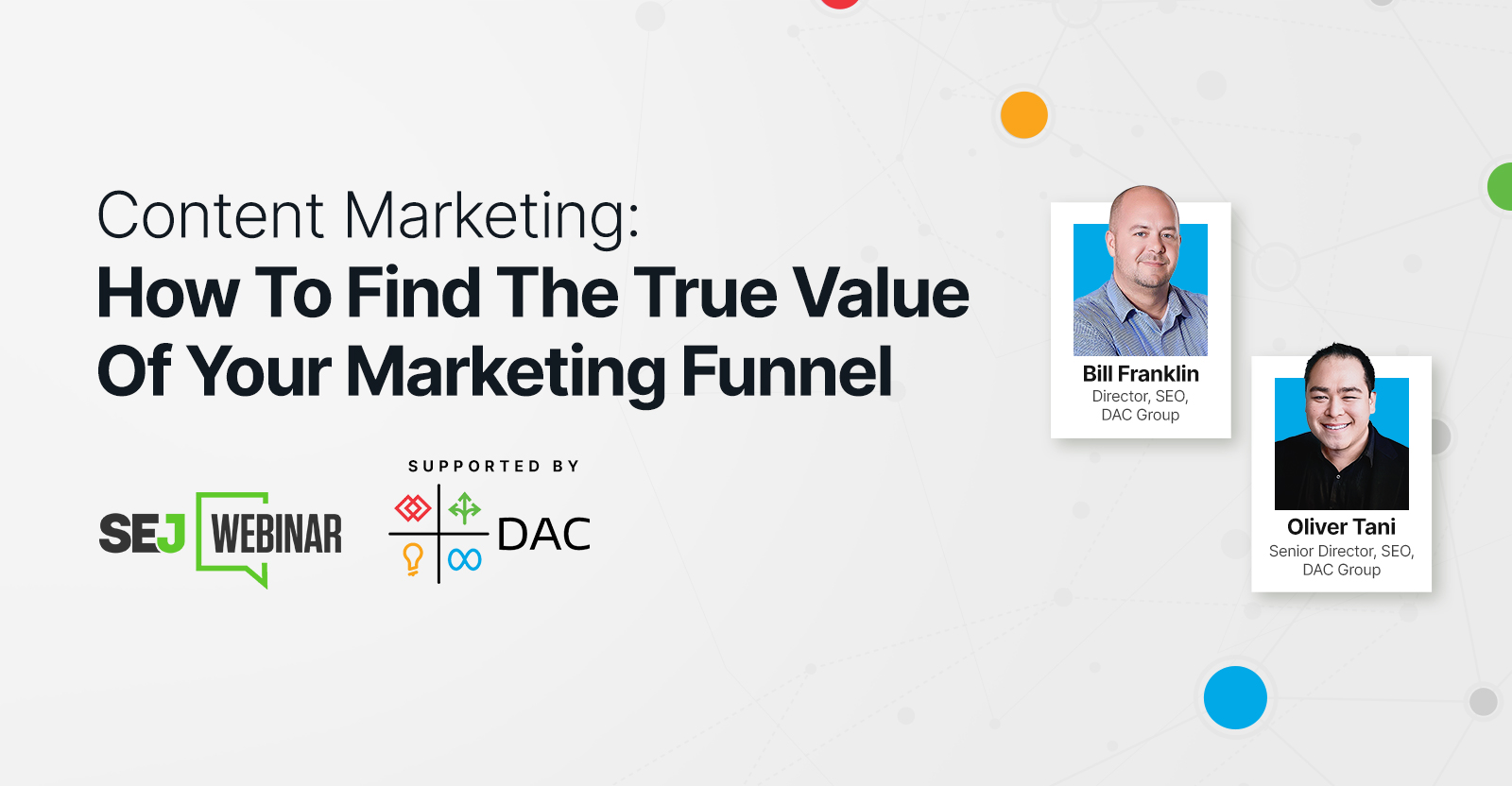
Understanding the impact of your content at every touchpoint of the customer journey is essential – but that’s easier said than done. From attracting potential leads to nurturing them into loyal customers, there are many touchpoints to look into.
So how do you identify and take advantage of these opportunities for growth?
Watch this on-demand webinar and learn a comprehensive approach for measuring the value of your content initiatives, so you can optimize resource allocation for maximum impact.
You’ll learn:
- Fresh methods for measuring your content’s impact.
- Fascinating insights using first-touch attribution, and how it differs from the usual last-touch perspective.
- Ways to persuade decision-makers to invest in more content by showcasing its value convincingly.
With Bill Franklin and Oliver Tani of DAC Group, we unravel the nuances of attribution modeling, emphasizing the significance of layering first-touch and last-touch attribution within your measurement strategy.
Check out these insights to help you craft compelling content tailored to each stage, using an approach rooted in first-hand experience to ensure your content resonates.
Whether you’re a seasoned marketer or new to content measurement, this webinar promises valuable insights and actionable tactics to elevate your SEO game and optimize your content initiatives for success.
View the slides below or check out the full webinar for all the details.
SEO
How to Find and Use Competitor Keywords
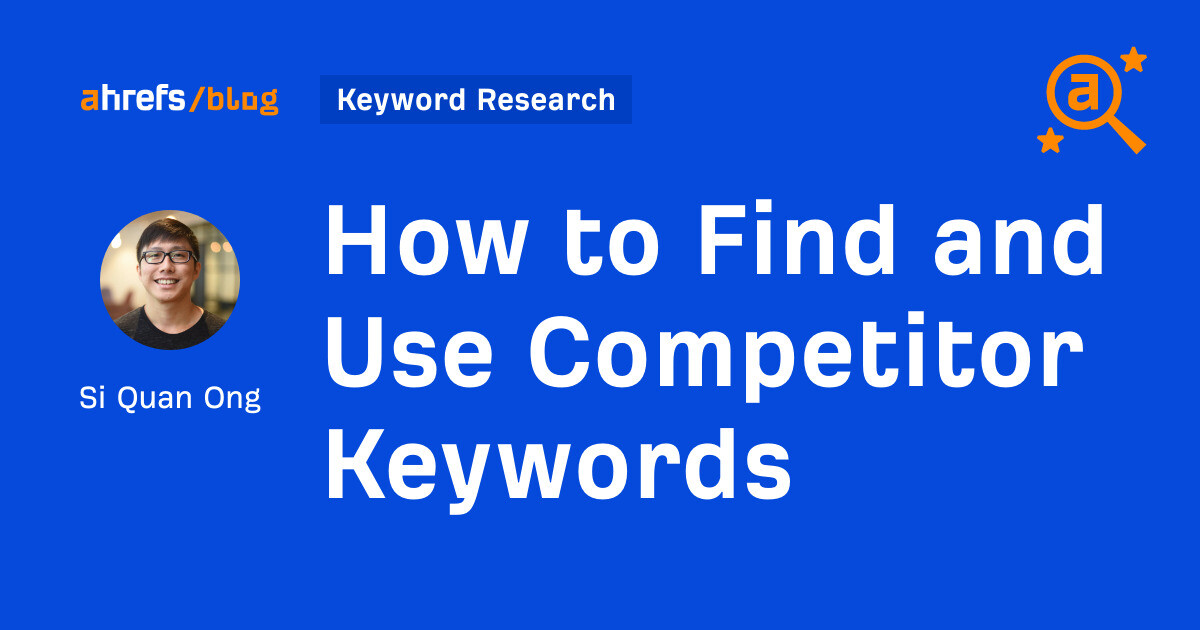
Competitor keywords are the keywords your rivals rank for in Google’s search results. They may rank organically or pay for Google Ads to rank in the paid results.
Knowing your competitors’ keywords is the easiest form of keyword research. If your competitors rank for or target particular keywords, it might be worth it for you to target them, too.
There is no way to see your competitors’ keywords without a tool like Ahrefs, which has a database of keywords and the sites that rank for them. As far as we know, Ahrefs has the biggest database of these keywords.
How to find all the keywords your competitor ranks for
- Go to Ahrefs’ Site Explorer
- Enter your competitor’s domain
- Go to the Organic keywords report
The report is sorted by traffic to show you the keywords sending your competitor the most visits. For example, Mailchimp gets most of its organic traffic from the keyword “mailchimp.”


Since you’re unlikely to rank for your competitor’s brand, you might want to exclude branded keywords from the report. You can do this by adding a Keyword > Doesn’t contain filter. In this example, we’ll filter out keywords containing “mailchimp” or any potential misspellings:
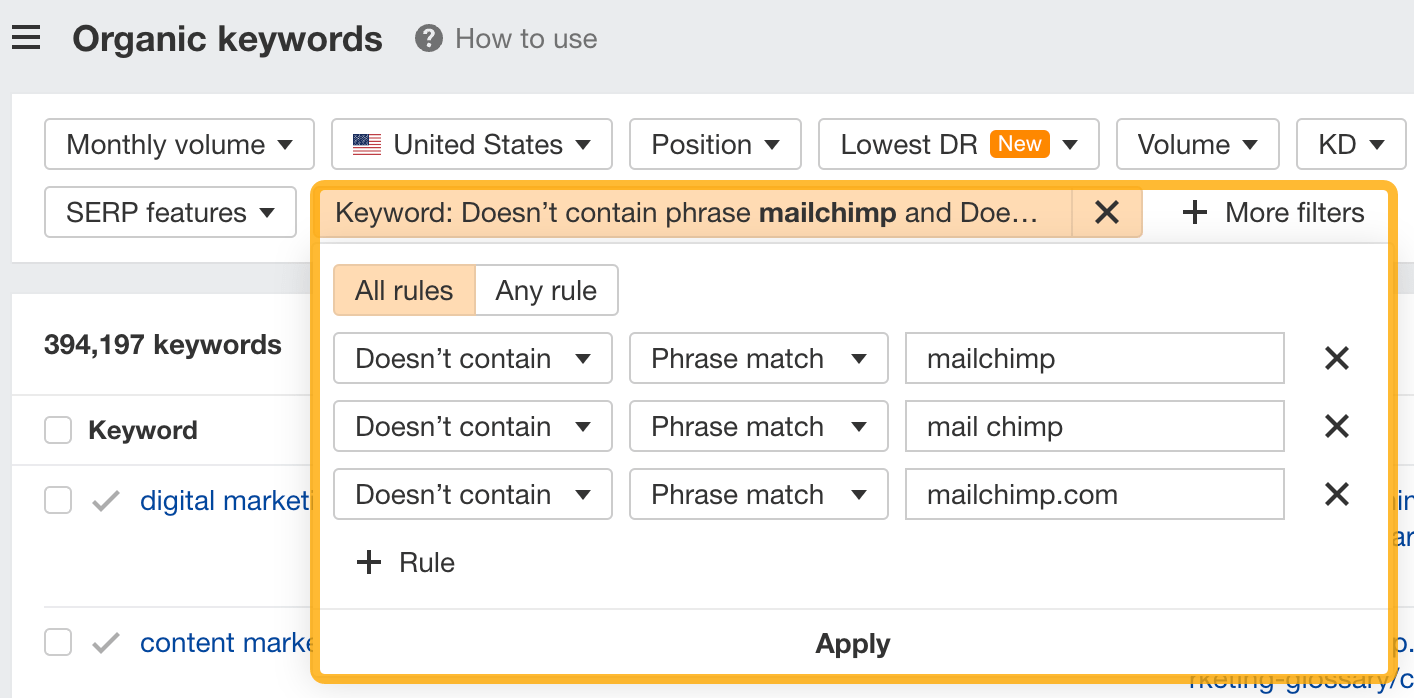

If you’re a new brand competing with one that’s established, you might also want to look for popular low-difficulty keywords. You can do this by setting the Volume filter to a minimum of 500 and the KD filter to a maximum of 10.
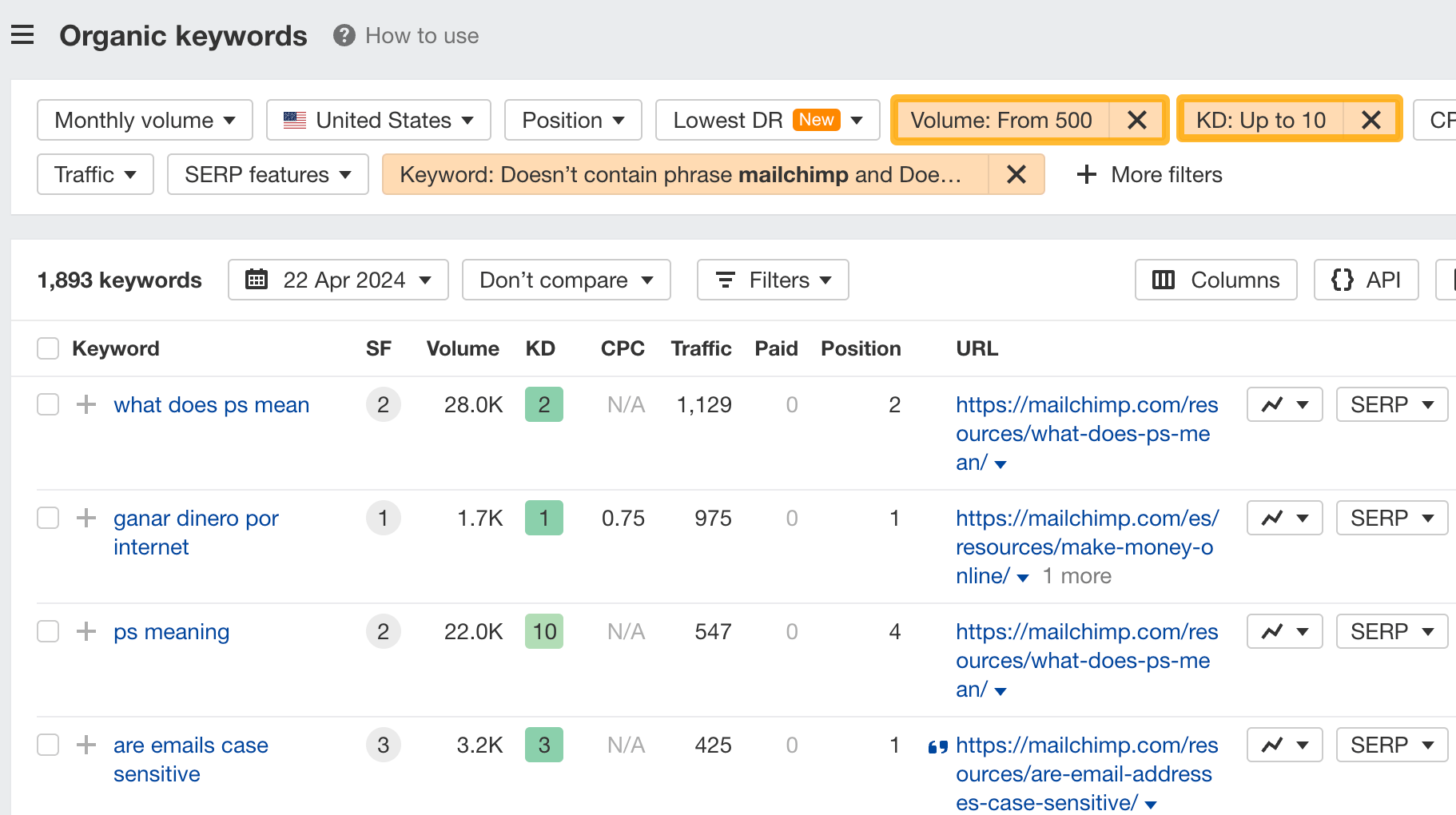

How to find keywords your competitor ranks for, but you don’t
- Go to Competitive Analysis
- Enter your domain in the This target doesn’t rank for section
- Enter your competitor’s domain in the But these competitors do section
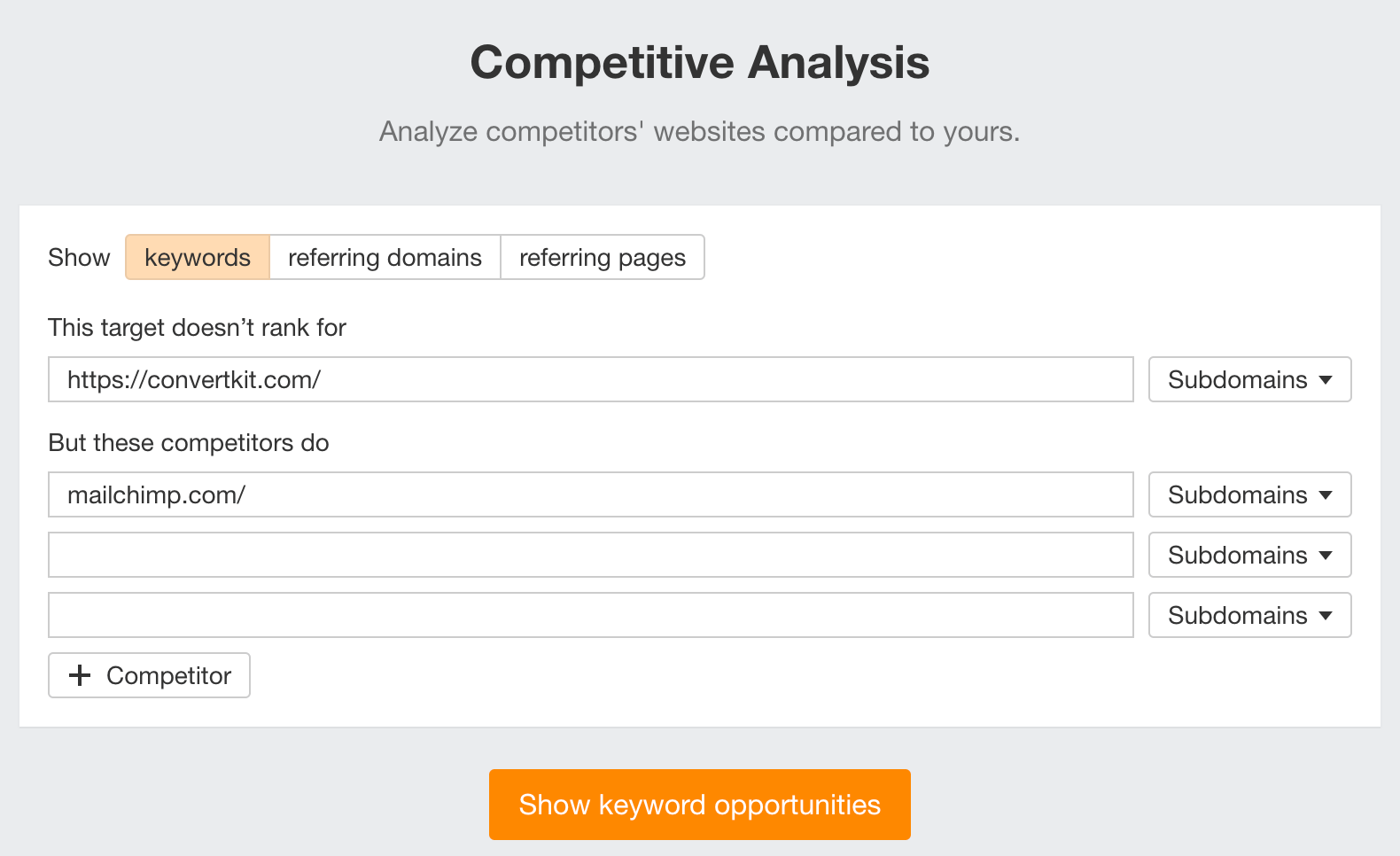

Hit “Show keyword opportunities,” and you’ll see all the keywords your competitor ranks for, but you don’t.
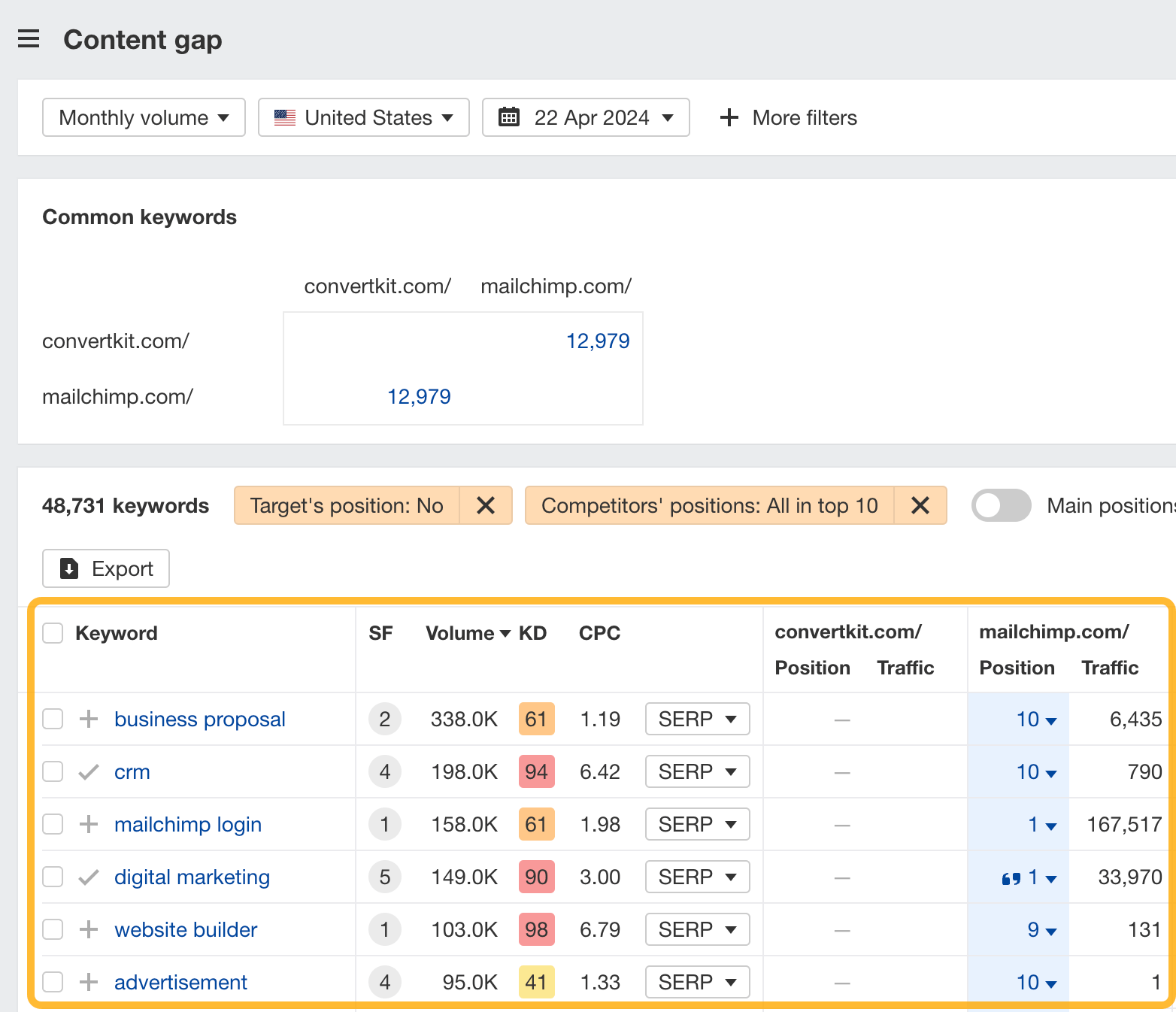

You can also add a Volume and KD filter to find popular, low-difficulty keywords in this report.
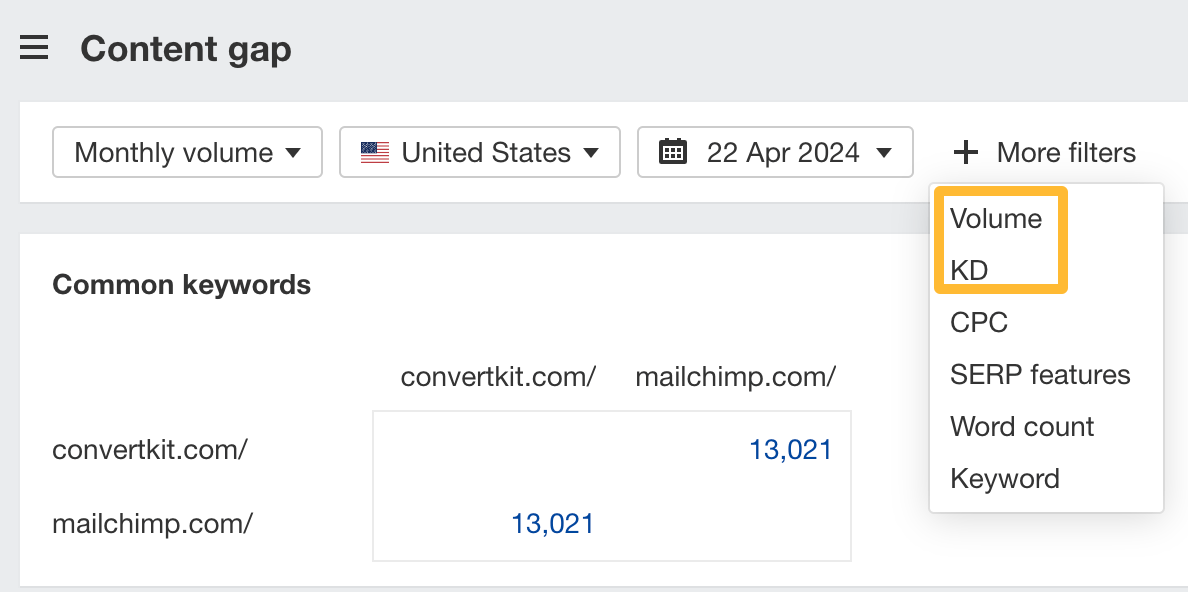

How to find keywords multiple competitors rank for, but you don’t
- Go to Competitive Analysis
- Enter your domain in the This target doesn’t rank for section
- Enter the domains of multiple competitors in the But these competitors do section
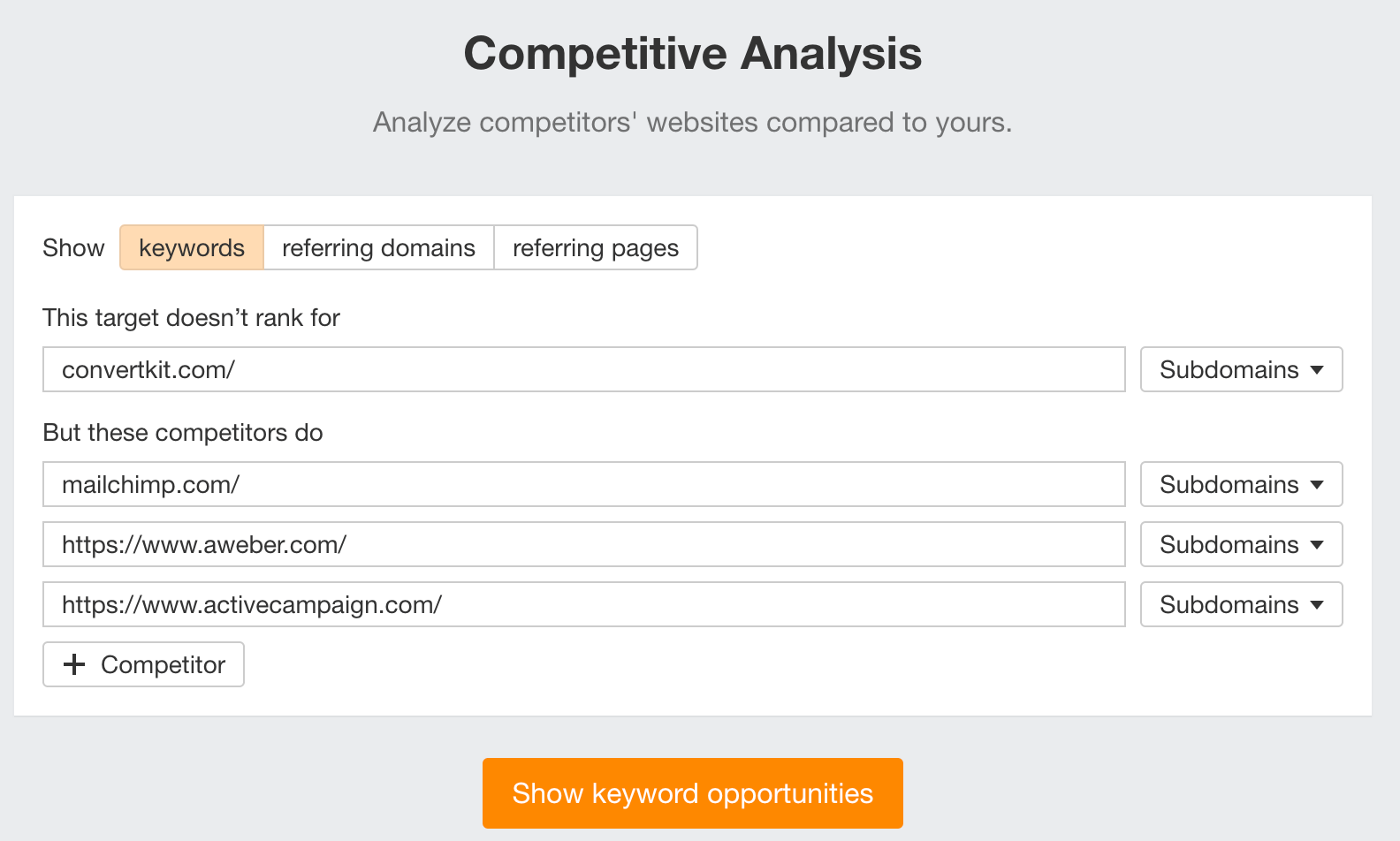

You’ll see all the keywords that at least one of these competitors ranks for, but you don’t.
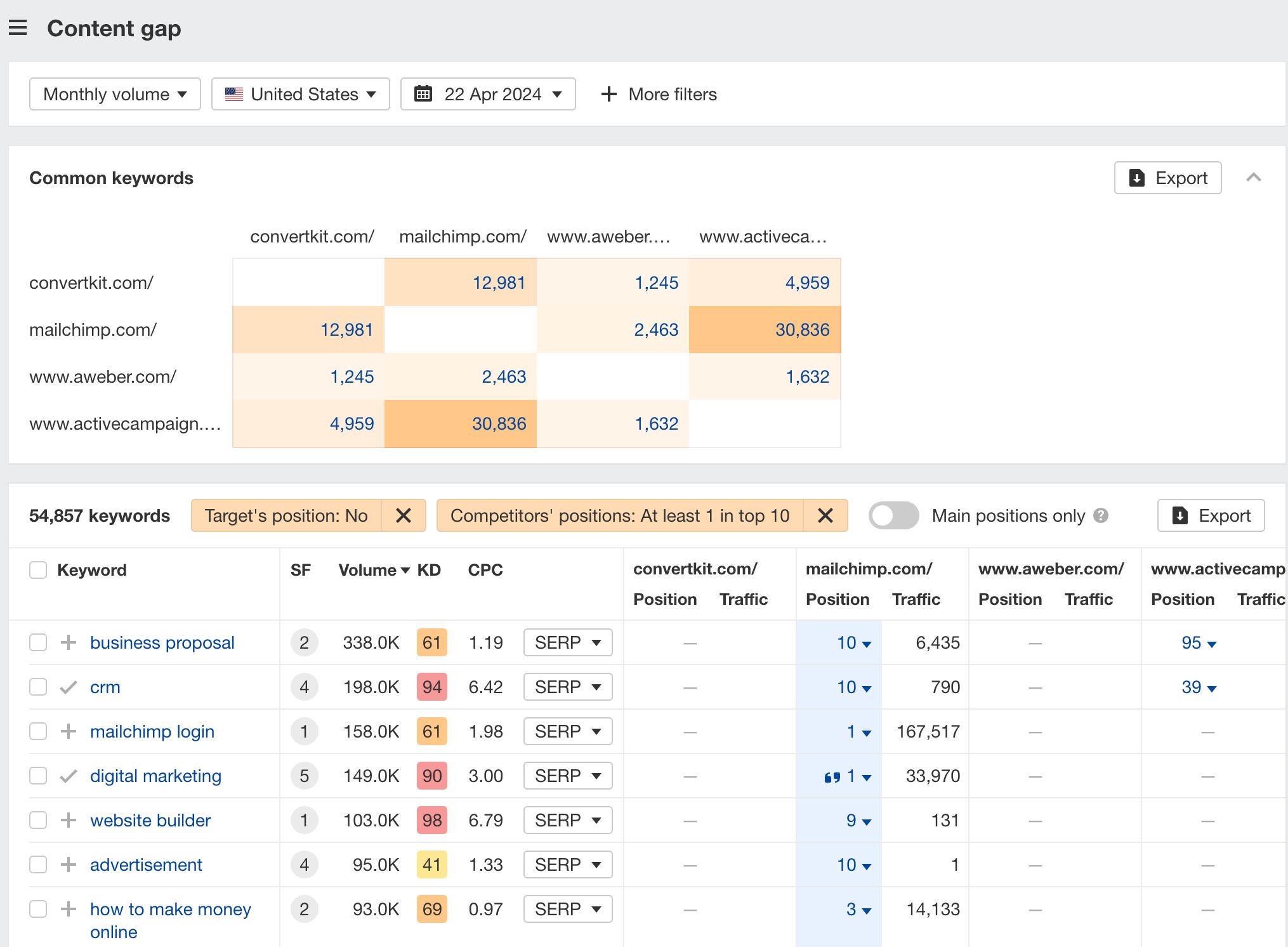

You can also narrow the list down to keywords that all competitors rank for. Click on the Competitors’ positions filter and choose All 3 competitors:
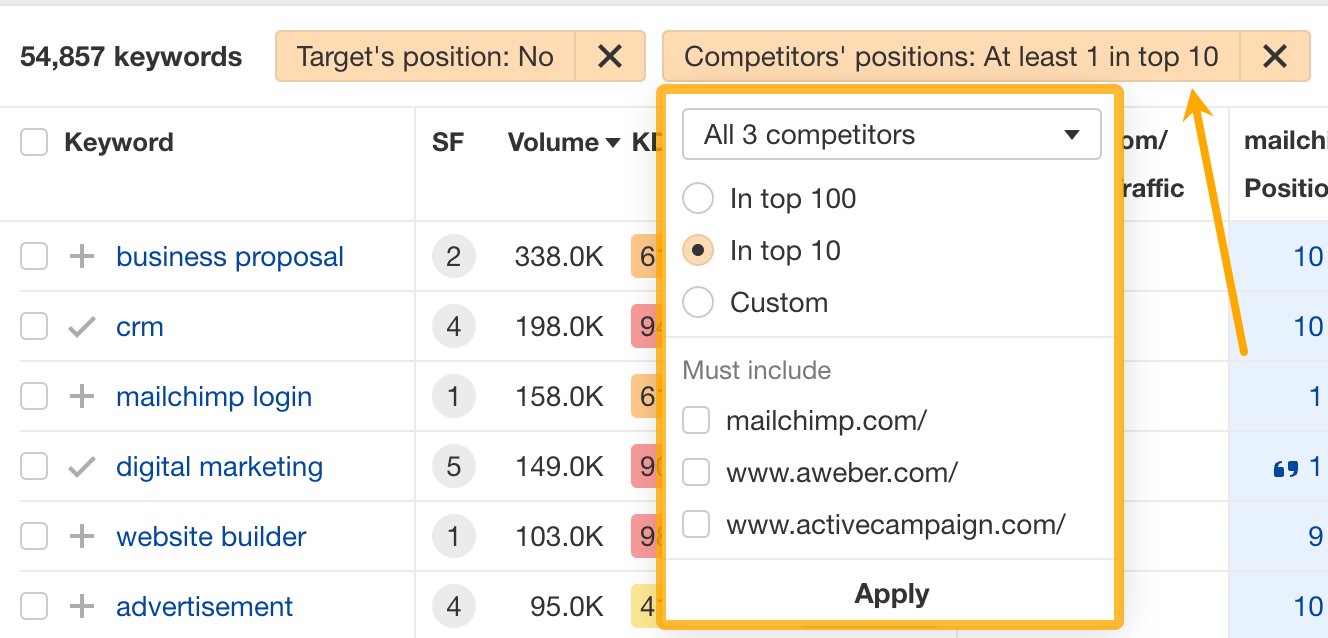

- Go to Ahrefs’ Site Explorer
- Enter your competitor’s domain
- Go to the Paid keywords report
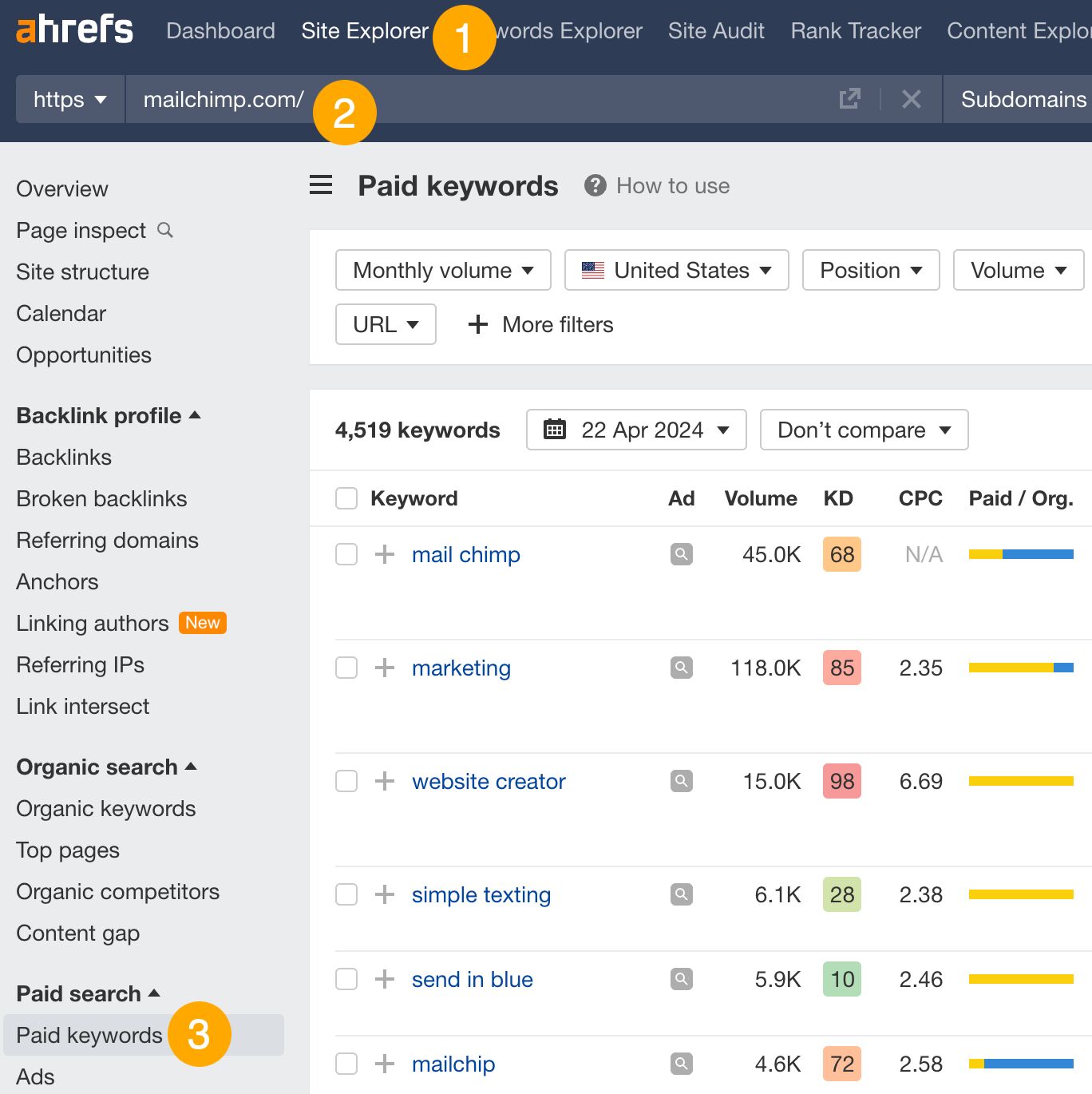

This report shows you the keywords your competitors are targeting via Google Ads.
Since your competitor is paying for traffic from these keywords, it may indicate that they’re profitable for them—and could be for you, too.
You know what keywords your competitors are ranking for or bidding on. But what do you do with them? There are basically three options.
1. Create pages to target these keywords
You can only rank for keywords if you have content about them. So, the most straightforward thing you can do for competitors’ keywords you want to rank for is to create pages to target them.
However, before you do this, it’s worth clustering your competitor’s keywords by Parent Topic. This will group keywords that mean the same or similar things so you can target them all with one page.
Here’s how to do that:
- Export your competitor’s keywords, either from the Organic Keywords or Content Gap report
- Paste them into Keywords Explorer
- Click the “Clusters by Parent Topic” tab
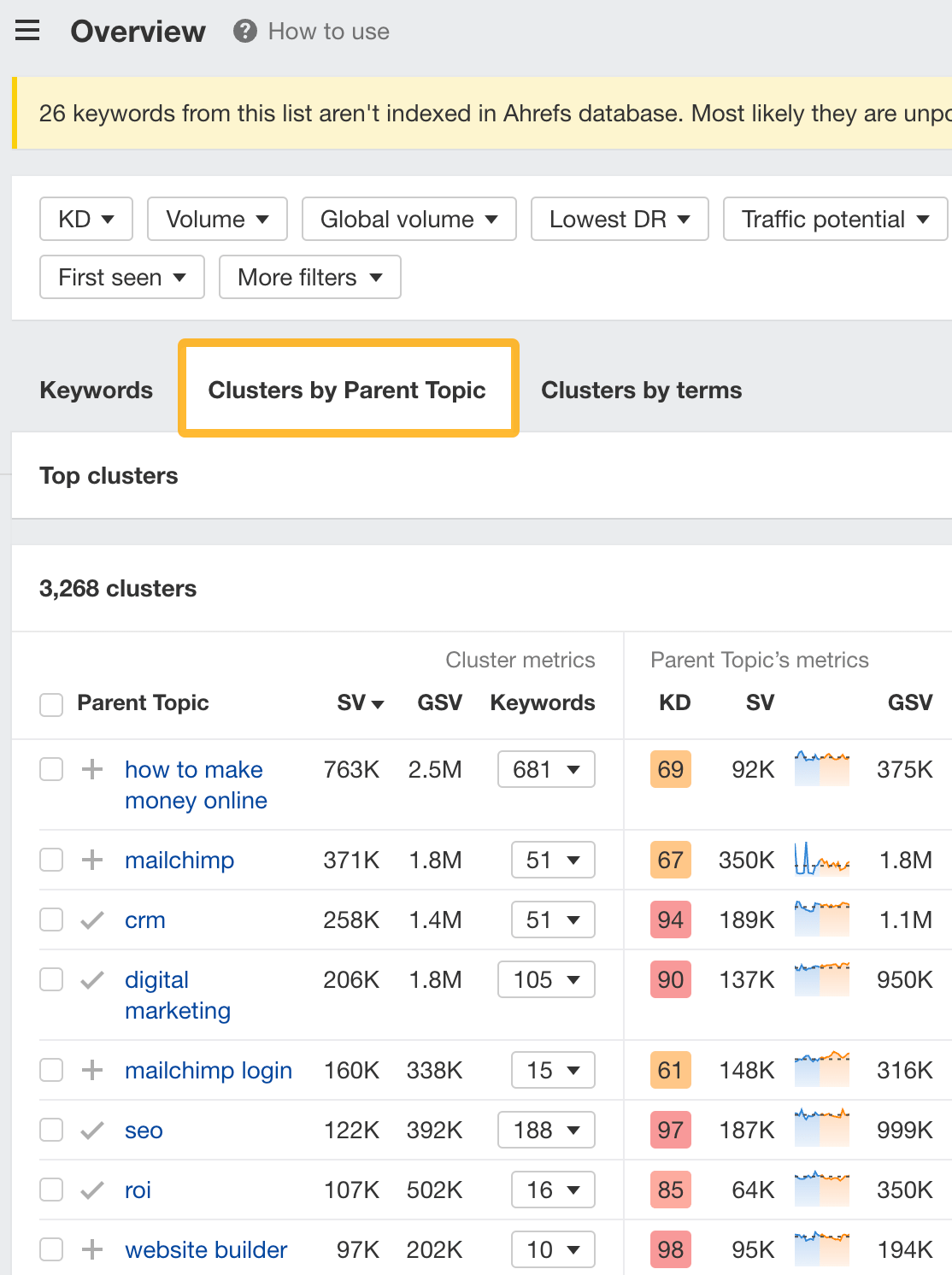

For example, MailChimp ranks for keywords like “what is digital marketing” and “digital marketing definition.” These and many others get clustered under the Parent Topic of “digital marketing” because people searching for them are all looking for the same thing: a definition of digital marketing. You only need to create one page to potentially rank for all these keywords.
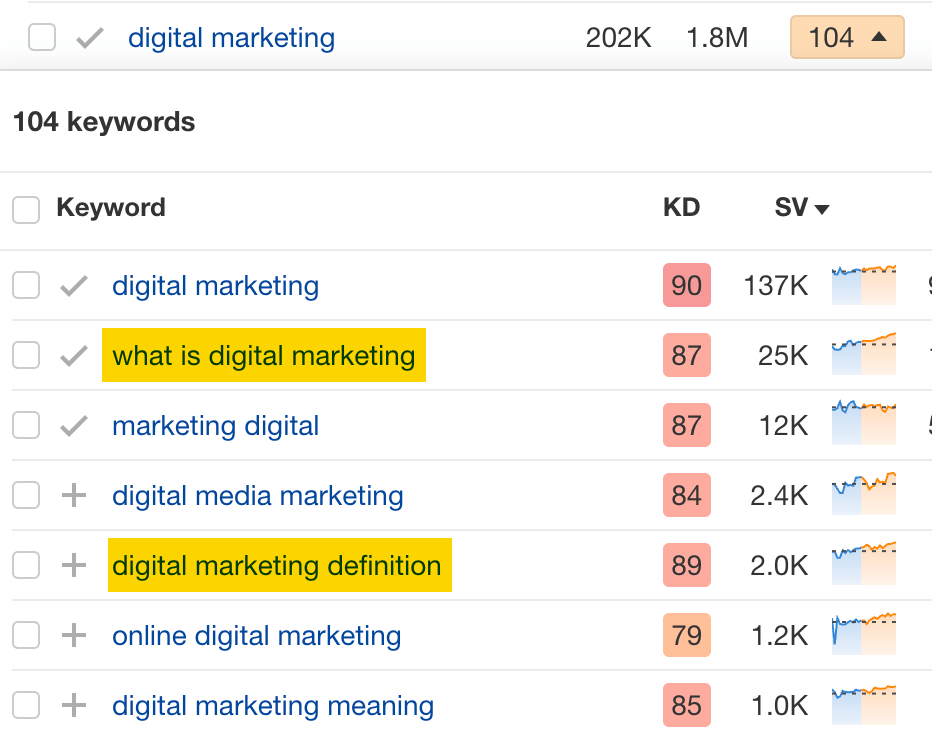

2. Optimize existing content by filling subtopics
You don’t always need to create new content to rank for competitors’ keywords. Sometimes, you can optimize the content you already have to rank for them.
How do you know which keywords you can do this for? Try this:
- Export your competitor’s keywords
- Paste them into Keywords Explorer
- Click the “Clusters by Parent Topic” tab
- Look for Parent Topics you already have content about
For example, if we analyze our competitor, we can see that seven keywords they rank for fall under the Parent Topic of “press release template.”


If we search our site, we see that we already have a page about this topic.


If we click the caret and check the keywords in the cluster, we see keywords like “press release example” and “press release format.”
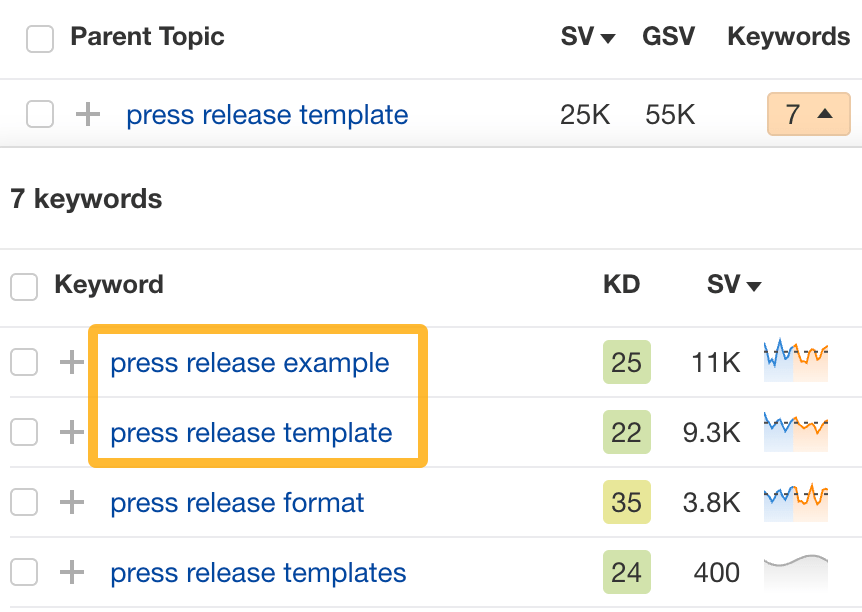

To rank for the keywords in the cluster, we can probably optimize the page we already have by adding sections about the subtopics of “press release examples” and “press release format.”
3. Target these keywords with Google Ads
Paid keywords are the simplest—look through the report and see if there are any relevant keywords you might want to target, too.
For example, Mailchimp is bidding for the keyword “how to create a newsletter.”


If you’re ConvertKit, you may also want to target this keyword since it’s relevant.
If you decide to target the same keyword via Google Ads, you can hover over the magnifying glass to see the ads your competitor is using.
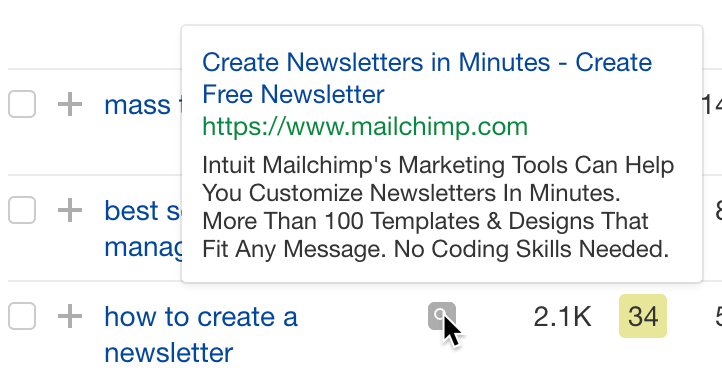

You can also see the landing page your competitor directs ad traffic to under the URL column.


Learn more
Check out more tutorials on how to do competitor keyword analysis:
-

 PPC6 days ago
PPC6 days ago19 Best SEO Tools in 2024 (For Every Use Case)
-

 MARKETING6 days ago
MARKETING6 days agoEcommerce evolution: Blurring the lines between B2B and B2C
-
SEARCHENGINES5 days ago
Daily Search Forum Recap: April 19, 2024
-
SEARCHENGINES6 days ago
Daily Search Forum Recap: April 18, 2024
-

 WORDPRESS5 days ago
WORDPRESS5 days agoHow to Make $5000 of Passive Income Every Month in WordPress
-

 SEO6 days ago
SEO6 days ago2024 WordPress Vulnerability Report Shows Errors Sites Keep Making
-

 WORDPRESS6 days ago
WORDPRESS6 days ago10 Amazing WordPress Design Resouces – WordPress.com News
-
WORDPRESS7 days ago
[GET] The7 Website And Ecommerce Builder For WordPress
















You must be logged in to post a comment Login